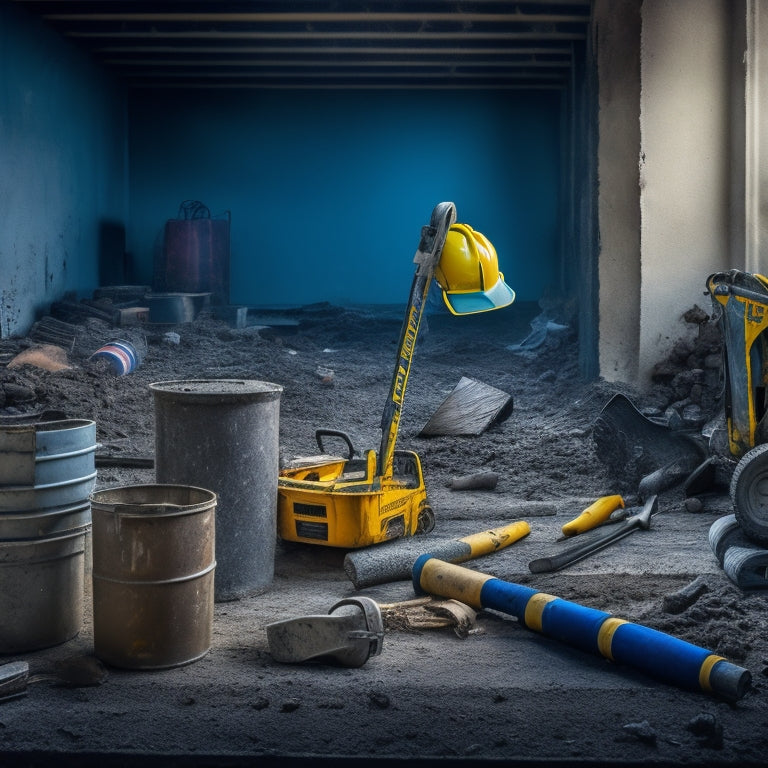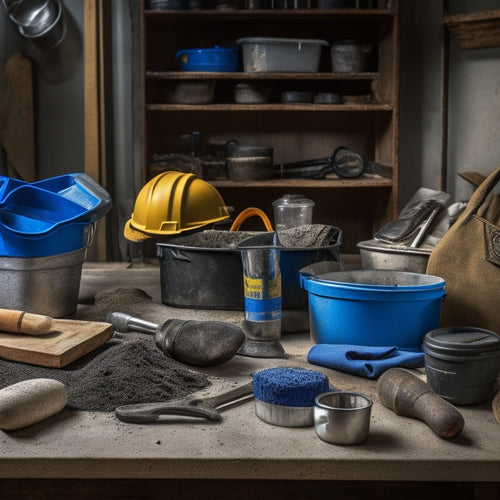
Essential Tools for Concrete Slab Removal
Share
You'll need a range of specialized tools to efficiently and safely remove a concrete slab. Breaking tools like electric jackhammers, demolition hammers, and hydraulic breakers will help you shatter the concrete. Cutting tools, such as concrete saws, will allow you to make precise cuts, while chipping tools like pneumatic chisels will help you remove the broken concrete. Drilling tools, like rotary hammers, and pry and removal tools, such as wrecking bars, will aid in the process. Additionally, surface preparation tools, like floor scrapers, and essential safety gear will guarantee a successful and accident-free project. Now that you have a sense of the tools involved, let's take a closer look at each one.
Key Takeaways
• Breaking tools like electric jackhammers, demolition hammers, and hydraulic breakers are essential for efficient concrete slab removal.
• Cutting tools, including concrete saws, are necessary for making precise cuts in concrete slabs for manageable sections.
• Chipping tools, such as pneumatic chisels, are used to break and remove concrete, with carbide-tipped chisels being durable and resistant to wear.
• Drilling tools, including rotary hammers, are required for drilling holes in concrete, with maintenance and safety protocols crucial for optimal performance.
• Pry and removal tools, like wrecking bars, are necessary for breaking and removing concrete slabs, with gentle and consistent pressure techniques essential for safety.
Electric Jackhammers for Breaking
When tackling a concrete slab removal project, you'll likely need to break up the slab into manageable pieces, and that's where electric jackhammers come in - powerful tools designed to efficiently deliver the high-impact blows necessary to shatter concrete.
These tools are equipped with vital features that make them ideal for the job, including variable speed controls, ergonomic grips, and robust motor housings.
To guarantee peak performance, it's important to perform regular electric jackhammer maintenance. This includes checking and replacing worn-out bits, inspecting cables for damage, and lubricating moving parts.
Additionally, you'll want to take into account the weight and balance of the jackhammer, as well as its vibration-reduction technology, to minimize operator fatigue.
Look for electric jackhammers with advanced features like anti-vibration handles and adjustable handles to customize the fit to your needs.
By selecting the right electric jackhammer and maintaining it properly, you'll be able to tackle even the toughest concrete slab removal projects with confidence and precision.
With the right tool in your hands, you'll be able to break up concrete efficiently and effectively, making the entire removal process much smoother.
Concrete Saws for Cutting
As you shift from breaking to cutting, concrete saws become an indispensable tool in your arsenal, allowing you to make precise cuts through the concrete slab, creating manageable sections for removal.
When selecting a concrete saw, consider the type of cut you need to make and the thickness of the slab. Walk-behind saws are ideal for straight cuts, while handheld saws are better suited for curved or intricate cuts.
To guarantee peak performance, it's vital to maintain your saw properly. Regularly check and replace worn or damaged blades, as dull blades can lead to reduced cutting efficiency and increased wear on the saw's motor. Additionally, keep the saw's air intake clean to prevent overheating.
Mastering various cutting techniques will also enhance your concrete slab removal efficiency. For instance, using a slow, controlled motion can help prevent kickback and improve cut quality. Moreover, understanding how to adjust the saw's depth and angle will enable you to make precise cuts in different types of concrete.
Demolition Hammers for Smashing
When you're selecting a demolition hammer for smashing concrete slabs, you'll want to take into account the weight of the hammer and the type of bit you'll need.
A heavier hammer will provide more force, but may be more difficult to maneuver, while a lighter hammer will be easier to handle but may not pack as much punch.
You'll also need to choose the right bit for the job, as different bits are designed for specific types of concrete and demolition tasks.
Hammer Weight Matters
You'll need a demolition hammer that packs a punch, so to speak, because the weight of your hammer directly correlates with the force it can deliver to break up that concrete slab. A heavier hammer will generally produce more impact force, making it easier to demolish the concrete.
However, don't assume that the heaviest hammer is always the best option. You need to evaluate the type of hammer, the material it's made of, and the weight distribution.
Here are some key factors to evaluate when choosing a demolition hammer:
-
Weight classes: Demolition hammers come in various weight classes, ranging from 10-60 pounds. Choose a weight that suits your strength and the size of the concrete slab.
-
Hammer types: There are electric, pneumatic, and hydraulic hammers. Electric hammers are suitable for smaller jobs, while pneumatic and hydraulic hammers are better for larger, more demanding projects.
-
Material: Hammers can be made of steel, titanium, or other materials. Titanium hammers are lighter and more durable, but also more expensive.
- Ergonomics: Look for a hammer with comfortable grips and a well-balanced design to reduce fatigue and improve control.
Bit Selection Importance
Selecting the right bit for your demolition hammer is essential, since it directly affects the tool's ability to efficiently smash through the concrete slab. A mismatch can lead to reduced productivity, increased wear on the hammer, and even safety hazards.
When choosing a bit, you'll need to evaluate the material it's made of. Tungsten carbide-tipped bits are ideal for concrete demolition, as they're extremely durable and resistant to wear.
You'll also need to think about the bit size, which will depend on the thickness of the concrete slab and the type of demolition you're doing. A larger bit will be more aggressive and better suited for breaking up thicker slabs, while a smaller bit will be more precise and better for detail work.
Make sure to choose a bit that's compatible with your hammer's shank size and type, and always follow the manufacturer's recommendations.
Pneumatic Chisels for Chipping
When you're working with pneumatic chisels for chipping, you'll need to carefully consider three key factors to get the job done efficiently and safely.
You'll have to select the right chisel bits for the task at hand, control the air pressure to avoid damaging the surrounding material, and take necessary safety precautions to protect yourself and others on site.
Chisel Bit Selection
Precision is key when choosing a chisel bit for your pneumatic chisel, as the right tool can efficiently shatter concrete while minimizing wear and tear on the chisel itself.
You'll want to evaluate the type of concrete you're working with, as well as the size and shape of the area you need to remove.
Here are some key factors to evaluate when selecting a chisel bit:
-
Chisel material: Carbide-tipped chisels are ideal for concrete removal, as they're more durable and resistant to wear.
-
Chisel types: There are several types of chisel bits, including flat, point, and wedge-shaped. Flat chisels are great for breaking up large areas, while point chisels are better suited for removing concrete in tighter spaces.
-
Bit size: Choose a bit size that's appropriate for the area you're working on. Larger bits are typically used for breaking up larger areas, while smaller bits are better for detail work.
- Bit angle: The angle of the chisel bit can affect its performance. A 90-degree angle is often used for breaking up concrete, while a 45-degree angle is better for removing concrete in tight spaces.
Air Pressure Control
With your chisel bit selected, you're ready to focus on enhancing air pressure control, which is vital for efficient and safe concrete removal using pneumatic chisels for chipping.
Proper air pressure regulation is key to achieving ideal performance and minimizing wear on your equipment. You'll want to confirm that your compressor can supply the required air pressure, typically between 90-120 PSI, depending on the manufacturer's recommendations.
Adjusting the air pressure regulator is important to maintaining the ideal pressure. You should aim to maintain a consistent pressure, as fluctuations can lead to reduced performance or even damage to the chisel. It's important to monitor the pressure gauge regularly to avoid over- or under-pressurization.
Additionally, consider the hose size and length, as these can affect air pressure delivery. A larger hose diameter and shorter length will result in less pressure drop, confirming that the chisel receives the required air pressure.
Safety Precautions Needed
You must take essential safety precautions when operating pneumatic chisels for concrete removal to prevent injuries and guarantee a safe working environment.
Pneumatic chisels can be hazardous if not handled properly, so it's vital to take the necessary steps to secure your safety and the safety of those around you.
Here are some essential safety precautions to take:
-
Conduct a hazard assessment: Identify potential hazards associated with operating pneumatic chisels, such as flying debris, noise, and vibration, and take steps to mitigate them.
-
Wear personal protective equipment (PPE): Wear safety glasses, ear protection, gloves, and a dust mask to protect yourself from debris and dust.
-
Establish emergency procedures: Develop a plan for emergency situations, such as a tool malfunction or injury, and ensure that all team members know what to do in case of an emergency.
- Follow manufacturer guidelines: Read and follow the manufacturer's instructions for operating and maintaining pneumatic chisels to guarantee safe and efficient use.
Hydraulic Breakers for Heavy Demolition
Heavy demolition projects often require the raw power of hydraulic breakers, which can exert up to 1,000 blows per minute to shatter even the thickest concrete slabs.
You'll need a breaker that can deliver maximum hydraulic efficiency to tackle the toughest demolition tasks. Look for a model with a high power-to-weight ratio, which will give you more breaking force without adding extra bulk.
When choosing a hydraulic breaker, evaluate the demolition techniques you'll be using. Will you be breaking up a large slab or demolishing a thick foundation? Different breakers are designed for specific tasks, so make sure you select one that's suitable for your project.
You'll also want to assess the breaker's durability and maintenance requirements. A well-maintained breaker will last longer and perform more efficiently, saving you time and money in the long run.
Rotary Hammers for Drilling Holes
Rotary hammers, designed to drill precise holes in concrete slabs, are essential tools for a variety of tasks, including anchor bolt installation and concrete sampling. As you prepare for your concrete slab removal project, you'll need to master the art of drilling holes efficiently and effectively. Here are some key considerations to keep in mind:
-
Drilling techniques: Develop a consistent drilling pattern to avoid damaging the surrounding concrete. Apply steady, controlled pressure to the hammer, and avoid applying too much pressure, which can cause the bit to bind or break.
-
Bit maintenance: Regularly inspect and maintain your drill bits to guarantee peak performance. Clean and lubricate the bits regularly, and replace them when they show signs of wear.
-
Hammer selection: Choose a rotary hammer that's suitable for the size and type of holes you need to drill. Consider factors such as power output, weight, and ergonomics.
- Safety protocols: Always wear protective gear, including safety glasses, gloves, and a dust mask, when operating a rotary hammer. Ensure a stable working environment and maintain a safe distance from the drilling area.
Wrecking Bars for Pry Bars
When tackling stubborn concrete slabs, a wrecking bar's pry bar capabilities prove invaluable for breaking up and removing the material, allowing you to efficiently separate it from the underlying surface.
As you insert the pry bar into the gap, you'll appreciate the wrecking bar's sturdy construction, typically made from high-strength steel alloys, which can withstand immense force without bending or breaking.
To optimize the effectiveness of your wrecking bar, employ advanced pry bar techniques, such as applying gentle, consistent pressure to gradually pry the slab loose. This approach helps prevent sudden, uncontrolled breakage that can lead to accidents or damage to surrounding structures.
When selecting a wrecking bar, consider the material's durability, weight, and handle ergonomics to guarantee peak performance and reduced fatigue. High-quality wrecking bars often feature reinforced joints, rust-resistant coatings, and textured grips, all of which contribute to enhanced control and precision during the concrete removal process.
Floor Scrapers for Surface Preparation
You'll need a reliable floor scraper to effectively remove old adhesives, thinset, and other residue from the underlying surface, preparing it for new concrete installations or overlays. This vital step in surface preparation guarantees a strong bond between the new concrete and the existing substrate.
When selecting a floor scraper, reflect on the type of residue you're dealing with and the surface you're working on.
Here are some key factors to ponder when choosing the right floor scraper for your project:
-
Ride-on floor scrapers for large, open areas and high-production demands.
-
Walk-behind floor scrapers for smaller areas and more precise control.
-
Edger floor scrapers for tight spaces and edges.
- Handheld floor scrapers for small, detailed areas and precision work.
Safety Gear for Protective Equipment
Before operating concrete slab removal tools, gear up with essential safety equipment to shield yourself from flying debris, dust, and other hazards.
You'll need protective gear that can withstand the demands of concrete removal. Start with protective gloves that offer grip, dexterity, and puncture resistance. Look for gloves made from heavy-duty materials like Kevlar or synthetic fibers that can resist cuts and abrasions.
Next, don't forget safety goggles that provide optical clarity and protection from debris. Choose goggles with anti-fog coatings and scratch-resistant lenses to guarantee clear visibility.
A face shield or respirator can also be worn to protect your face and lungs from dust and debris.
Steel-toed boots with slip-resistant soles will keep your feet safe from heavy tools and slippery surfaces.
Finally, wear a dust mask or respirator to prevent inhaling concrete dust and other airborne particles.
By wearing this essential safety gear, you'll be well-protected to tackle even the toughest concrete slab removal projects.
Frequently Asked Questions
Can I Use a Regular Hammer for Concrete Slab Removal?
When it comes to concrete slab removal, you might wonder if a regular hammer will get the job done.
Unfortunately, its hammer effectiveness is limited. The force you can generate with a standard hammer won't be enough to crack the slab efficiently.
Instead, you'll need to employ advanced demolition techniques that require specialized tools, such as a jackhammer or a pneumatic breaker, to break up the concrete effectively.
How Do I Prevent Dust Inhalation During Demolition?
You're about to release a storm of dust and debris, but don't let it cloud your judgment - or your lungs.
When it comes to demolition, dust control is essential. You'll need respiratory protection that's up to the task.
Invest in a high-quality mask with a HEPA filter, and make sure it fits snugly.
Don't rely on flimsy disposable masks; they won't cut it. You're better than that.
Take control of the dust, and it won't control you.
What Safety Gear Is Required for Operating Heavy Machinery?
When operating heavy machinery, you'll need to prioritize your safety above all else.
You'll require safety gear that's up to the task, including safety goggles to shield your eyes from debris and dust.
Don't forget protective gloves to maintain a secure grip on the machinery's controls while protecting your hands from vibrations and abrasions.
Can I Rent Concrete Removal Tools Instead of Buying Them?
You're considering renting concrete removal tools instead of buying them, and that's a smart move.
Renting can be a cost-effective option, especially if you only need the tools for a one-time project. You'll avoid the hefty upfront costs and storage hassles that come with ownership.
Plus, tool rental benefits include access to specialized equipment and reduced maintenance responsibilities, freeing you to focus on getting the job done efficiently.
Are There Any Environmental Regulations for Concrete Disposal?
When you're planning concrete disposal, you'll need to navigate environmental regulations.
You're responsible for ensuring that concrete waste is handled and disposed of correctly. Familiarize yourself with hazardous waste regulations in your area, as concrete can contain hazardous materials.
Additionally, explore concrete recycling options, which can be a more sustainable and cost-effective approach. By doing so, you'll avoid potential fines and contribute to a more environmentally friendly process.
Conclusion
As you stand victorious on the battlefield of concrete slab removal, you've conquered the unyielding foe with your arsenal of essential tools.
The electric jackhammers were the cavalry, breaking through the toughest defenses.
The concrete saws were the precision snipers, cutting through with ease.
The demolition hammers were the heavy artillery, smashing through the toughest strongholds.
With these tools, you've emerged triumphant, ready to rebuild on the ruins of the old.
Related Posts
-

5 Tools Needed for Quick Fix Concrete Mixing
You'll need five essential tools to tackle a quick fix concrete mixing project efficiently. First, you'll require a s...
-

Why You Need These Concrete Overlay Tools
When tackling a concrete overlay project, you need the right tools to achieve a flawless finish and avoid costly mist...
-

What Tools Are Needed for Concrete Wall Foundations
You'll need a thorough array of tools and equipment to construct a concrete wall foundation that meets structural int...


